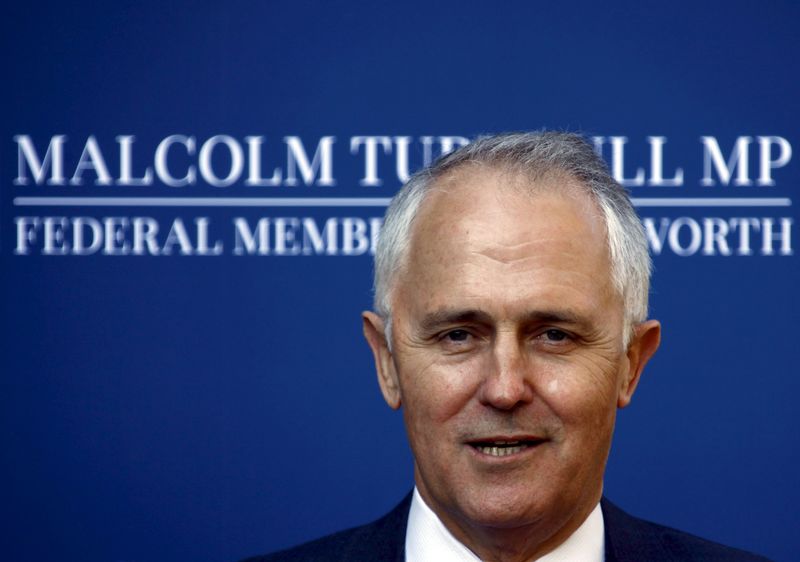(Bloomberg Opinion) -- Why can’t Australia just elect a prime minister and stick with its choice?
With the incumbent Malcolm Turnbull promising Thursday to hold the second party meeting in five days to decide on his stewardship, the country may soon be looking at its sixth leader in little more than eight years.
Episodes like this haven’t been uncommon. The long reigns of figures like Billy Hughes, Robert Menzies, Bob Hawke and John Howard have been interspersed with tumultuous interregnums when the major factions on the right and left sought to realign themselves. That’s what appears to be happening now — but the issues on which the sides are organizing suggest a darker turn.
Turnbull’s main antagonists in parliament have been Home Affairs Minister Peter Dutton and Tony Abbott, the former prime minister whom Turnbull himself knifed to win the leadership. With the support of News Corp (NASDAQ:NWSA).-owned media, they’ve been attempting to turn the governing right-of-center Liberal party into a more consistently right-wing grouping.
Whereas similar movements once split on issues of trade (when the Protectionist and Free Trade parties duked it out in the early years after Federation in 1901) and welfare spending (during the turmoil that embraced the administrations of John Gorton, William McMahon and Gough Whitlam in the early 1970s), the key divisions this time are climate change and immigration.
The proximate cause for the current crisis is the failure of Turnbull’s National Energy Guarantee, an attempt to set long-term power policies that fell victim to the right’s insistence on skewing the playing field in favor of coal, despite the fact that building new thermal generators costs around three times as much as wind and solar.
A grim drumbeat beneath that has been the right’s attempt to make race and immigration signature issues.
Dutton has shown a willingness to deal in racist dog-whistles. Allowing the immigration of Lebanese Muslims in the 1970s was a “mistake,” he argued in 2016. White South African farmers should be singled out for fast-track migration because they’d “integrate into our society,” he said this year, unlike people who’d “lead a life on welfare” or aren’t “of good character”. Meanwhile, in recent months he’s repeatedly claimed (in defiance of the views of Victoria state’s police commissioner) that Sudanese gangs are terrorizing Melbourne.
The language is eerily similar to some of the less inflammatory rhetoric of minor-party Senator Fraser Anning, who caused outrage last week with a speech that echoed the Holocaust in calling for “a final solution to the immigration problem.”
Anning’s demand that future migrants reflect “the historic European Christian composition of Australian society” and his call for an end to Muslim immigration only differ from Dutton’s comments about Lebanese Muslims and white South Africans in being more explicit. In that, Dutton’s style goes back to the White Australia migration policy established at the country’s 1901 founding, which for decades used an un-passable dictation test to ban non-European migrants without being seen to do so.
The tragedy of this latest round of realignment is that it risks squandering the greatest virtues of modern Australia.
Since dumping the last vestiges of the White Australia policy in 1973, the country has become a remarkably successful multicultural society, where almost half of people are first- or second-generation migrants, one in four has roots outside Europe, and one of the five free-to-air television channels broadcasts news in almost 70 languages. While the bipartisan support for Australia’s brutal treatment of refugees who arrive by boat is a stain on this record, it’s notable that even Dutton pays regular lip service to multiculturalism.
Australia’s openness to migration is a key factor behind almost 27 years of uninterrupted economic growth since the last recession ended in 1991. It also sets the country up well to tackle the challenges of an aging population, as Reserve Bank of Australia Governor Philip Lowe said in a speech earlier this month.
It’s notable that even if you strip out the effects of population increase on economic growth by looking only at per-capita GDP, three of the four weakest decades were in the period between 1910 and 1940, at the height of the White Australia policy.
The same goes for climate and energy. As the world’s driest continent and one of its largest agricultural exporters, Australia is particularly at risk from the effects of a changing climate. It’s currently suffering one of the worst droughts in living memory, and rising sea temperatures may destroy the Great Barrier Reef by mid-century.
Blessed with abundant wind and solar power, even major emitters such as Energy Australia Pty and AGL Energy Ltd. are planning for a carbon-free future in spite of the best efforts of the wreckers on the right of the government. Householders and businesses are increasingly taking matters into their own hands to generate solar power from their own roofs, and the state of South Australia will be producing almost three-quarters of its electricity from renewable sources by 2021.
That’s why the stakes are so high in this moment of turmoil. Just when the world may feel it’s stumbling down a darkening path, Australia offers the prospect of a different way: a country that’s outgrown its vicious origins to become one of the richest and happiest on the back of migration, trade, and an embrace of its environment. The costs of choosing the wrong course could reverberate for generations.
